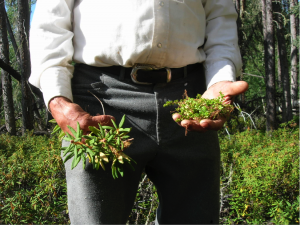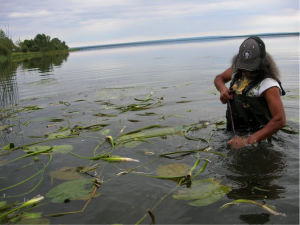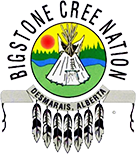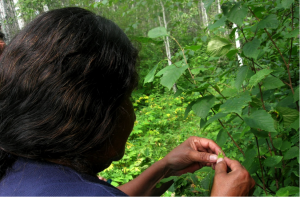Bigstone Cree
Wabasca-Desmarais, Alberta
| Conservation & Protected Areas |
| Customary Tenure |
| Life Projects |
| Livelihoods & Food Sovereignty |
| Politics of Resource Extraction |
Bigstone Cree Nation is the second largest First Nation in Alberta. Their territory in the subarctic boreal forests of northern Alberta sits atop the Athabasca oil sands deposits, and is a region that is experiencing extreme levels of extractive activities. The Bigstone Cree Nation are signatories of Treaty 8, signed in 1899. This treaty promises that the First Nations of Treaty 8 territory have the right to use public Crown lands for traditional uses and activities; this promise is protected under section 35 of The Constitution Act, 1982. For this reason, the federal and provincial governments have a duty to consult the Bigstone Cree Nation, along with other Treaty 8 First Nations, regarding the impacts of proposed projects on public land.


Federal and provincial guidelines are such that the duty to consult is transferred to third party companies who are proposing public land projects. These companies often pay First Nations to do their own assessments of the potential impacts of resource extractive projects on their territories. Treena Gladue, CICADA partner, is the Bigstone Cree Nation’s Traditional Land Use Study Coordinator. In their land use studies, the Bigstone Cree Nation speak with knowledge-holders, Elders, trappers, and other community members, with the goal of preserving and protecting as much of their territory as they can. However, at the 2015 CICADA conference, Janelle Baker, doctoral researcher in anthropology at McGill University and CICADA student, explained that traditional land use assessments present a double bind for First Nations. On the one hand, if they do decide to engage in the consultation process and produce a report, the resource extraction company selects certain sections from the report to respond to, while in fact ignoring the majority of the report. This process is then viewed as being sufficient in order to go ahead with the project. As explains Treena, “We’re just recording what the companies are going to destroy.” On the other hand, if a First Nation decides to not participate in this consultation process, the company is allowed to go forward with the project as long as they can prove that they attempted to consult.
“Bigstone Cree Nation is committed to the pursuit of the highest quality of life for all its members.”

Because Crown consultation policies have failed to protect the Bigstone Cree Nation’s traditional way of life or to honour their constitutionally-protected rights, the Nation has adopted their own consultation policy: “We the Bigstone Cree Nation have the right and responsibility to address issues regarding natural resource exploitation within our traditional lands and assert that any activity in the Bigstone Cree Nation territory requires consultation with respect to impacts on our treaty and inherent rights as confirmed in section 35 of The Constitution Act of 1982.” The Bigstone Cree Nation believes that, unless they take action on their own initiative, their way of life will become impossible.
The Bigstone Cree Nation employs a number of strategies besides land use assessments for dealing with the impacts of oil on their land:
Kituskeenow Tours and Demonstrations
Bigstone Cree Nation continues to organize rallies during which they halt traffic or attend events. The purpose of these demonstrations is to inform industry workers that they are on Bigstone Cree Nation traditional territory. They also regularly drive around project sites to observe the goings-on at these areas.

Bigstone Cree Nation Indicators for Wild Food Contamination
Melvin Beaver, director the Bigstone Cree Government Industry Relations Office, and Janelle Baker are research partners through CICADA studying BCN’s concerns about wild food contamination from industrial activities, notably oil and gas. Baker’s research focuses on Cree knowledge, indicators, and concerns about wild food contamination. 
Associated Projects


